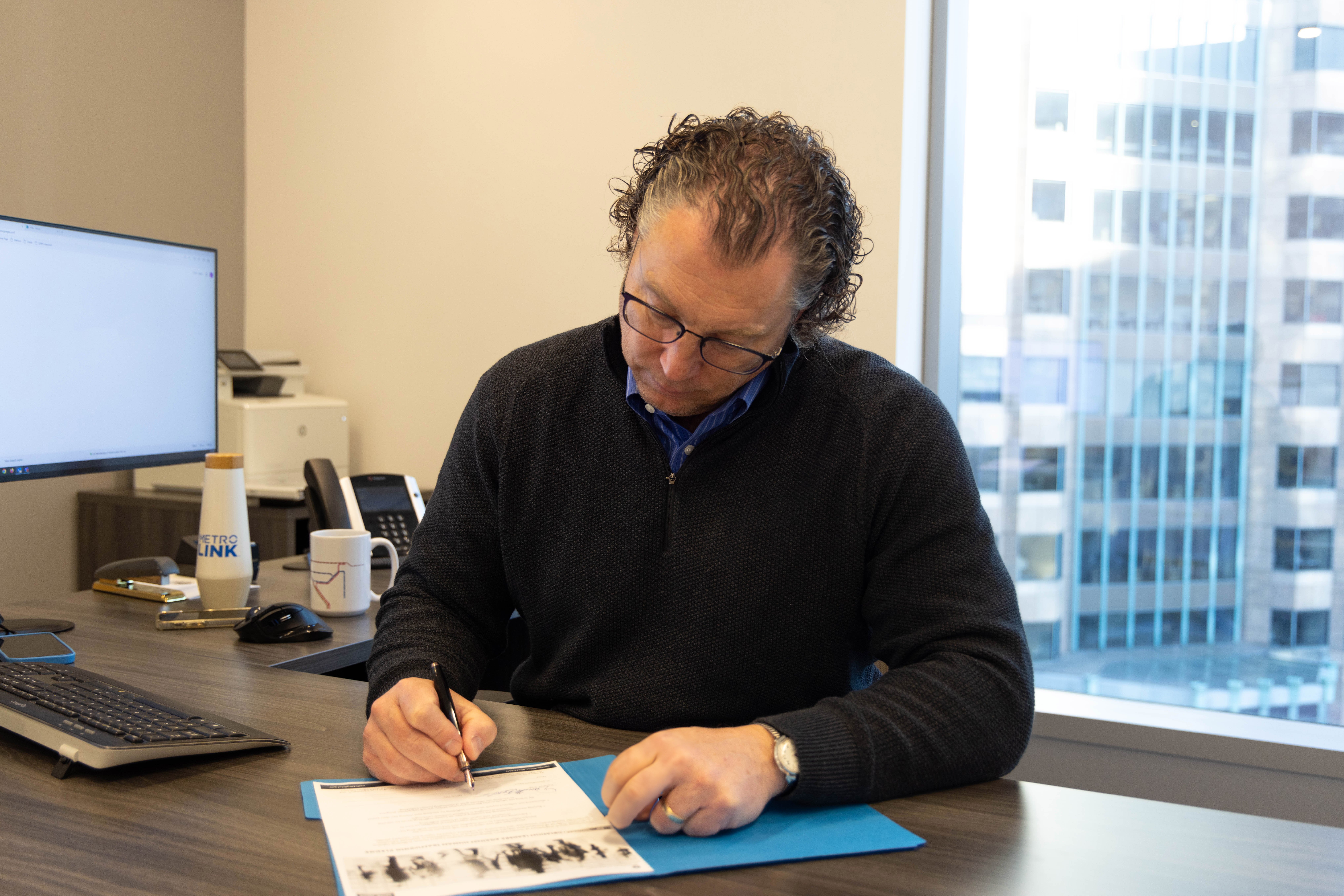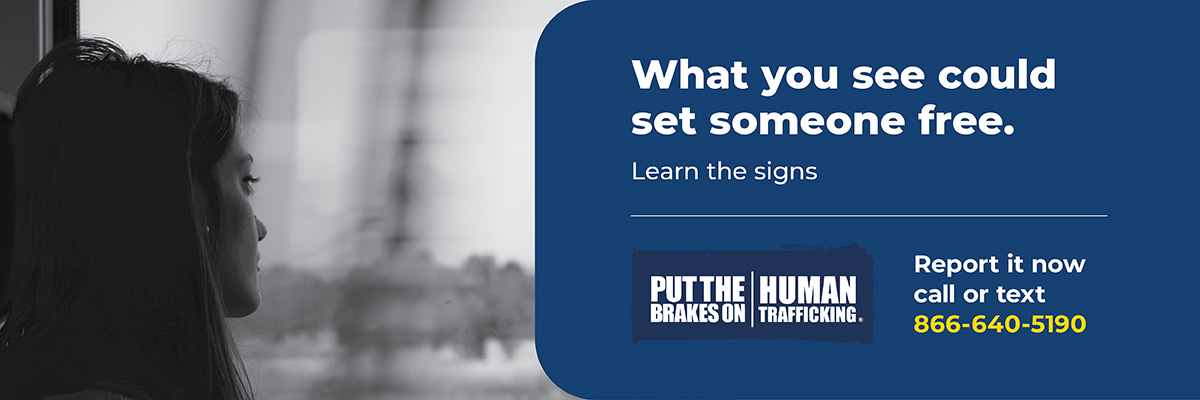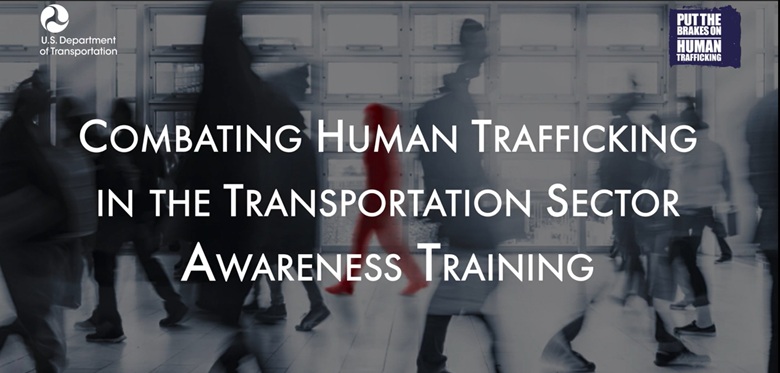
Combating Human Trafficking
What is Human Trafficking?
U.S. law defines human trafficking as the use of force, fraud or coercion to compel a person into commercial sex acts or labor against their will. An estimated 27.6 million men, women and children are sold into prostitution, domestic servitude or other forced labor worldwide. Human trafficking often hides in plain sight. Traffickers use our transportation systems, including trains, buses and roads, to move their victims. Being aware of this reality is the first step towards making a difference.
RecognizING the Signs
Red flags, or indicators, can help alert you to a possible incidence of human trafficking. Recognizing these indicators helps to identify potential victims. When you see indicators of human trafficking, report your tip, as it could change someone's life. The following are four common indicators of human trafficking.

ID or Travel Documents
If a potential victim appears to have no control or possession of their travel identification, money and/or other documents.

Having Restricted Movement
If a potential victim appears to have their movement and/or social interaction restricted by a co-traveler.
![]()
Lacking Knowledge
A potential victim may have difficulty speaking to logical travel plans or answering basic questions including where they are located.

Non-Genuine Relationships
If the potential victim appears to be accompanied by a non-genuine parent/guardian or partner.
How You Can Help
Join us in the fight against human trafficking. Metrolink encourages everyone, from employees to riders, to be vigilant and report any suspicious behavior. Together, we can create an environment where human trafficking has no place to hide.
Never intervene personally if you suspect someone may be the victim of human trafficking. Instead, report your suspicions as soon as possible.
| AGENCIES | SERVICES PROVIDED | PHONE |
|---|---|---|
| Emergency |
If you believe you or the suspected victim are in immediate danger. |
Call or text 911 |
| Metrolink's Security Operations Center |
Report your suspicions to a nearby Metrolink representative or to the Security Operations Center |
Call or text: 866-640-5190 |
| National Human Trafficking Hotline | To get more help | Call 1-888-373-7888, or text INFO or HELP to BEFREE (233733) |

FAQ
According to the Polaris Project, which operates the National Human Trafficking Hotline, U.S. law defines human trafficking as the use of force, fraud or coercion to compel a person into commercial sex acts or labor against their will. Human trafficking does not require the element of transportation to be considered a crime. It should not be confused with human smuggling, which is the illegal movement of a person across a border, though the two crimes can sometimes be related.
You can be the difference in someone’s life simply by recognizing and reporting the signs of human trafficking. Some common indicators to look for include:
- Fearful, anxious, or submissive behavior
- Avoiding eye contact
- Poor physical health or hygiene
- Traveling with few personal belongings
- Being coached on what to say
- Restricted movement or social interaction
- Lack of control over personal documents or money
- Minors with non-genuine guardians
- Language barriers
- Confusion about location or destination
- Branding tattoos or scars
- No logical means of reaching a destination
- Vague job offers or excessive work hours
- Offering sex for basic needs
Not all of the above indicators will be present in every human trafficking situation, and their presence or absence is not necessarily proof of human trafficking.
The hand signal for help is performed by holding your hand up with your thumb tucked into your palm, then folding your fingers down, symbolically trapping your thumb in your fingers. It was intentionally designed as a single continuous hand movement, rather than a sign held in one position, that could be made easily visible.
- Never intervene personally
- Report suspicions to Metrolink representative or to Metrolink’s Security Operations Center at 866-640-5190
- Or call 911 if in immediate danger
- Provide detailed information: transportation details, physical descriptions, observed behaviors
- Let the authorities investigate and respond
- Reporting may help someone escape.
Human traffickers often use transportation systems to operate. Traffickers frequent transportation hubs to recruit victims of sex trafficking and forced labor, and traffickers may also use transit systems to transport victims between locations where they will be abused and exploited.
- The U.S. Department of Transportation oversees the multimodal Transportation Leaders Against Human Trafficking counter-trafficking campaign and offers a variety of valuable educational resources, including a 20-minute informative video about combating human trafficking in the transportation sector.
- Truckers Against Trafficking (TAT) is a national nonprofit organization that unites transportation professionals from across the industry in the fight against human trafficking. TAT’s 30-minute Busing on the Lookout (BOTL) training video demonstrates the importance of educating frontline transit employees.
- The National Center for Rural Road Safety has developed a publicly available 90-minute webinar on Human Trafficking and the Role of Transportation.
- The U.S. Department of Homeland Security’s Blue Campaign works to increase public awareness of human trafficking, including what to look for and how to respond.
- The Polaris Project is a leading U.S.-based nonprofit organization committed to the eradication of human trafficking. In addition to operating the 24/7 National Human Trafficking Hotline, Polaris Project offers a free Human Trafficking 101 course. Though the organization receives some federal funding, it is not a governmental, law enforcement or immigration authority.
To get help and connect with a service provider in your area, call the National Human Trafficking Hotline (NHTH) at 1-888-373-7888 or text HELP to 233733. The NHTH is a national, toll-free hotline available to answer calls from anywhere in the country, 24 hours a day, 7 days a week, every day of the year. The NHTH is not a law enforcement or immigration authority and is operated by a nongovernmental organization funded by the Federal government.
The State of California’s Office of the Attorney General has also compiled a list of state and national resources, including the California’s Victims’ Services Unit.
Yes. In the United States, children and adults of all genders are exploited through human trafficking across every state and territory and in urban, rural, and tribal areas. In 2021, the National Human Trafficking Hotline received more than 1,300 tips from the state of California – more than any other U.S. state.
Human trafficking and human smuggling are separate crimes, though they can be related. Human trafficking is the use of force, fraud or coercion to compel a person into commercial sex acts or labor against their will and is also referred to as modern day slavery. Human smuggling is the illegal movement of a person across a border. In some cases, human smuggling can turn into human trafficking.


